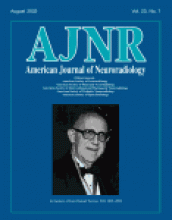Abstract
BACKGROUND AND PURPOSE: Rotational angiography (RA) and digital subtraction angiography (DSA) together may depict more intracranial aneurysms than DSA alone. We compared the diagnostic value of 3D RA and biplanar DSA in detecting, classifying, and planning treatment for ruptured intracranial aneurysms.
METHODS: A total of 53 patients with acute subarachnoid hemorrhage (Hunt and Hess grades I–V) underwent angiography with both methods. DSA was performed in two to six standard projections in every vascular territory. Three-dimensional RA datasets were evaluated by using surface-shaded display and maximum intensity projection. The usefulness of DSA images and 3D datasets in detecting aneurysms (number, configuration) and treatment planning were retrospectively analyzed in a blinded manner.
RESULTS: In 42 patients, 56 aneurysms were detected, (one to five per patient; size, 0.6–20.4 mm); no aneurysm was found in 11 patients. RA revealed seven aneurysms not seen at conventional DSA. RA failed to depict one aneurysm visible only in a compression series. Delineation of the aneurysmal neck improved with RA in 71% of cases; the parent vessel and its relationship to adjacent vessels was demonstrated better with RA than with DSA in 45% and 50%, respectively. Endovascular treatment was proposed in nine patients; microsurgical therapy, in 26. In seven patients, both options were rated as being equal. Actual treatment consisted of eight endovascular procedures and 30 neurosurgical operations. Four patients died before therapy.
CONCLUSION: Compared with DSA, 3D RA allows more exact depiction of anatomic details that are important in planning surgery and interventional therapy for intracranial aneurysms. RA depicted more aneurysms.
- Copyright © American Society of Neuroradiology











